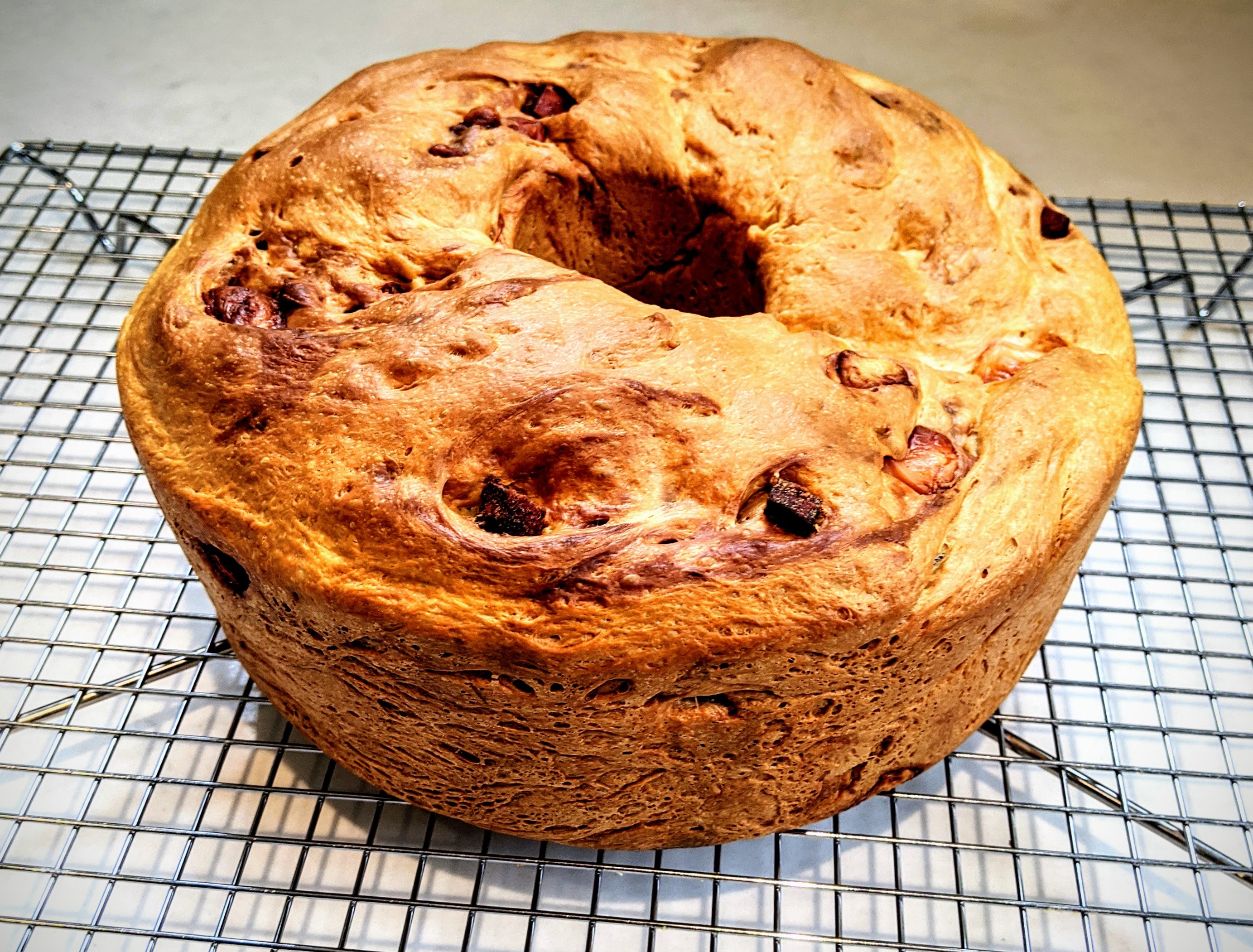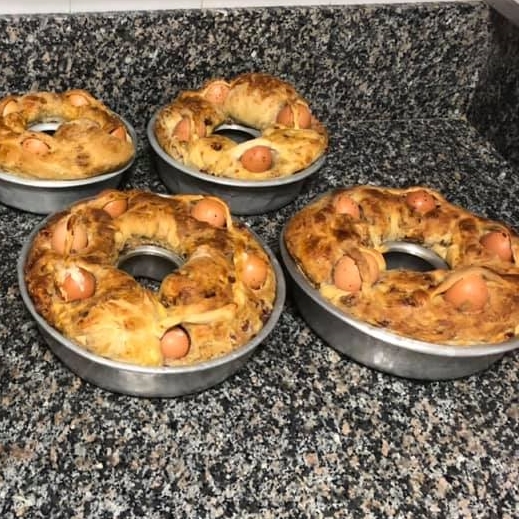Casatiello on:
[Wikipedia]
[Google]
[Amazon]
Casatiello ( nap, casatiéllo, it, casatello) is a
 Casatiello is based on a bread dough enriched with cheese (usually smoked
Casatiello is based on a bread dough enriched with cheese (usually smoked
 ''Tortano'' is a very similar product: the two main differences are the use of eggs, which in casatiello are also placed in the upper part and not only hard-boiled and in small pieces in the dough as in tortano, and that of
''Tortano'' is a very similar product: the two main differences are the use of eggs, which in casatiello are also placed in the upper part and not only hard-boiled and in small pieces in the dough as in tortano, and that of
 In reference to the heaviness of the dish, in Naples it is customary to say "Sí proprio 'nu casatiéllo" ( it, sei proprio un casatiello, lit. "You are really a casatiello") to mean "You are a person of quality but also an indigestible boring person".
In reference to the heaviness of the dish, in Naples it is customary to say "Sí proprio 'nu casatiéllo" ( it, sei proprio un casatiello, lit. "You are really a casatiello") to mean "You are a person of quality but also an indigestible boring person".
leaven
In cooking, a leavening agent () or raising agent, also called a leaven () or leavener, is any one of a number of substances used in doughs and batters that cause a foaming action (gas bubbles) that lightens and softens the mixture. An altern ...
ed savory bread originating from Naples prepared during the Easter
Easter,Traditional names for the feast in English are "Easter Day", as in the '' Book of Common Prayer''; "Easter Sunday", used by James Ussher''The Whole Works of the Most Rev. James Ussher, Volume 4'') and Samuel Pepys''The Diary of Samuel ...
period.
Its basic ingredients are flour, lard, cheese, salami, cracklings Cracklings (USA), crackling (British English), also known as scratchings, are the solid material which remains after rendering animal fat and skin to produce lard, tallow, or schmaltz, or as the result of roasting meat. It is often eaten as a snack ...
, eggs and black pepper.
Etymology
The bread's name derives probably from the Neapolitan word ''caso'' ( it, cacio, "cheese", hence ''casatiello''), an ingredient that is part of its dough.History
The existence of casatiello, like that of '' pastiera'', another Neapolitan Easter product, has been attested at least since the seventeenth century: the proof comes from the folk tale ''La gatta Cenerentola'' ("Cinderella the Cat") published in 1634–1636 in the short story collection '' Pentamerone, ovvero Lo Cunto de li cunti'' byGiambattista Basile
Giambattista Basile (February 1566 – February 1632) was an Italian poet, courtier, and fairy tale collector. His collections include the oldest recorded forms of many well-known (and more obscure) European fairy tales. He is chiefly remembere ...
, a Neapolitan writer (writing in the Neapolitan language) who lived between the 16th and 17th centuries.
The bread is mentioned in the passage where he describes the king's celebrations to find the girl who had lost her slipper
Slippers are light footwear that are easy to put on and off and are intended to be worn indoors, particularly at home. They provide comfort and protection for the feet when walking indoors.
History
The recorded history of slippers can be traced ...
:
In the 19th century, casatiello is also mentioned in the book ''Costumi e tradizioni di Napoli e dintorni'' (Customs and traditions of Naples and the surrounding area), published in 1858 and edited by Francesco De Bourcard, a Neapolitan scholar of Swiss origin, who describes the bread and its preparation, stating that ''il casatello'' (sic
The Latin adverb ''sic'' (; "thus", "just as"; in full: , "thus was it written") inserted after a quoted word or passage indicates that the quoted matter has been transcribed or translated exactly as found in the source text, complete with any e ...
) was baked at home for the Easter
Easter,Traditional names for the feast in English are "Easter Day", as in the '' Book of Common Prayer''; "Easter Sunday", used by James Ussher''The Whole Works of the Most Rev. James Ussher, Volume 4'') and Samuel Pepys''The Diary of Samuel ...
lunch and offered as a gift to neighbors and "to the servants and the laundress
A washerwoman or laundress is a woman who takes in laundry. Both terms are now old-fashioned; equivalent work nowadays is done by a laundry worker in large commercial premises, or a laundrette (laundromat) attendant.
Description
As evidenced ...
".
Ingredients and preparation
scamorza
Scamorza () is a Southern Italian cow's milk cheese. It can also be made from other milks, but that is less common. It is a stretched-curd cheese, in which the fresh curd matures in its own whey for several hours to allow acidity to develop th ...
, but also pecorino
Pecorino cheeses are hard Italian cheeses made from sheep's milk. The name "" derives from ''pecora'' which means sheep in Italian.
Overview
Of the six main varieties of pecorino, all of which have Protected Designation of Origin (PDO) stat ...
and some parmesan
Parmesan ( it, Parmigiano Reggiano; ) is an Italian hard, granular cheese produced from cows’ milk and aged at least 12 months.
It is named after two of the areas which produce it, the provinces of Parma and Reggio Emilia (''Parmigiano'' ...
can be used), lard, '' cicoli'' and other cured meats.
The dough is worked into the shape of a doughnut, placed in a mould and left to rise for a long time, at least 12 hours; if made with quick leaven, about two hours are enough. The bread is then baked, traditionally in a wood-fired oven
upA double oven
A ceramic oven
An oven is a tool which is used to expose materials to a hot environment. Ovens contain a hollow chamber and provide a means of heating the chamber in a controlled way. In use since antiquity, they have been use ...
.
Casatiello is usually prepared on Good Friday, left to rise overnight, baked the following day, and eaten on Holy Saturday and Easter Monday.
The casatiello, unlike similar products such as ''tortano'', is prepared around Easter, from which it borrows the symbolism: the strips of bread arranged to cage the eggs half-submerged in the dough represent the cross on which Jesus died while the ring shape is a reminder of the cyclical nature of the Easter resurrection and of Christ
Jesus, likely from he, יֵשׁוּעַ, translit=Yēšūaʿ, label=Hebrew/Aramaic ( AD 30 or 33), also referred to as Jesus Christ or Jesus of Nazareth (among other names and titles), was a first-century Jewish preacher and religious ...
's crown of thorns
According to the New Testament, a woven crown of thorns ( or grc, ἀκάνθινος στέφανος, akanthinos stephanos, label=none) was placed on the head of Jesus during the events leading up to his crucifixion. It was one of the in ...
.
During the preparation, the eggs are placed whole and baked in the oven together with the dough. While some bakers put them raw, others prefer to use already hard-boiled eggs. The cooking takes place at for about 60 minutes.
The bread can also be used as a packed lunch
A packed lunch (also called pack lunch, sack lunch or brown-bag lunch in North America) is a lunch which is prepared before arriving at the place where it is to be eaten. Typically, it is prepared at home or at a hotel, or produced commercially ...
during the traditional trips out of town ( it, Gite fuori porta) on Easter Monday.
Casatiello can be kept for a maximum of two or three days, then it becomes harder and harder. In Naples, a stale casatiello is named "ammazzaruto", literally "not enough leavened", and then by extension "hard".
Variants
 ''Tortano'' is a very similar product: the two main differences are the use of eggs, which in casatiello are also placed in the upper part and not only hard-boiled and in small pieces in the dough as in tortano, and that of
''Tortano'' is a very similar product: the two main differences are the use of eggs, which in casatiello are also placed in the upper part and not only hard-boiled and in small pieces in the dough as in tortano, and that of charcuterie
Charcuterie ( , also ; ; from french: chair, , flesh, label=none, and french: cuit, , cooked, label=none) is a French term for a branch of cooking devoted to prepared meat products, such as bacon, ham, sausage, terrines, ''galantines'', ''ballo ...
, which is part of the dough filling in casatiello, whereas it is omitted in tortano.
Sweet variant
The sweet version of casatiello has as main ingredients eggs, sugar, lard and icing, and is decorated on the surface with ''diavulilli'' ("little devils", Neapolitan for "coloureddragée
A dragée ( ; ), also known as confetto (; ), malbas, Jordan almond, or sugared almond in the U.K, is a bite-sized form of confectionery with a hard outer shell. It is often used for another purpose (e.g. decorative, symbolic, medicinal, etc.) i ...
s"). This variant is widespread in Caserta
Caserta () is the capital of the province of Caserta in the Campania region of Italy. It is an important agricultural, commercial, and industrial '' comune'' and city. Caserta is located on the edge of the Campanian plain at the foot of the Ca ...
, in the island of Procida and in the Benevento and Vesuvian area. Other sweet versions are found in Monte di Procida
Monte di Procida ( nap, Monte 'e Proceta; locally ) a small ''comune'' (municipality) in the Metropolitan City of Naples in the Italian region of Campania, located about west of Naples, facing the island of Procida. Monte di Procida includes the ...
and in the Nola
Nola is a town and a municipality in the Metropolitan City of Naples, Campania, southern Italy. It lies on the plain between Mount Vesuvius and the Apennines. It is traditionally credited as the diocese that introduced bells to Christian wor ...
no area.
In popular culture
 In reference to the heaviness of the dish, in Naples it is customary to say "Sí proprio 'nu casatiéllo" ( it, sei proprio un casatiello, lit. "You are really a casatiello") to mean "You are a person of quality but also an indigestible boring person".
In reference to the heaviness of the dish, in Naples it is customary to say "Sí proprio 'nu casatiéllo" ( it, sei proprio un casatiello, lit. "You are really a casatiello") to mean "You are a person of quality but also an indigestible boring person".
Citations
Cited sources
*General sources
* * * * {{Cite book , last=Capasso , first=Emilia , url=https://books.google.com/books?id=PlGpuvDwtrMC , title=I sapori della cucina vesuviana , publisher=Guida Editori , year=2010 , isbn=978-8860428172 , location=Napoli , language=it Yeast breads Sweet breads Easter bread Italian breads Neapolitan cuisine Easter traditions in Italy